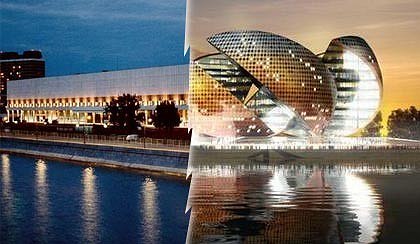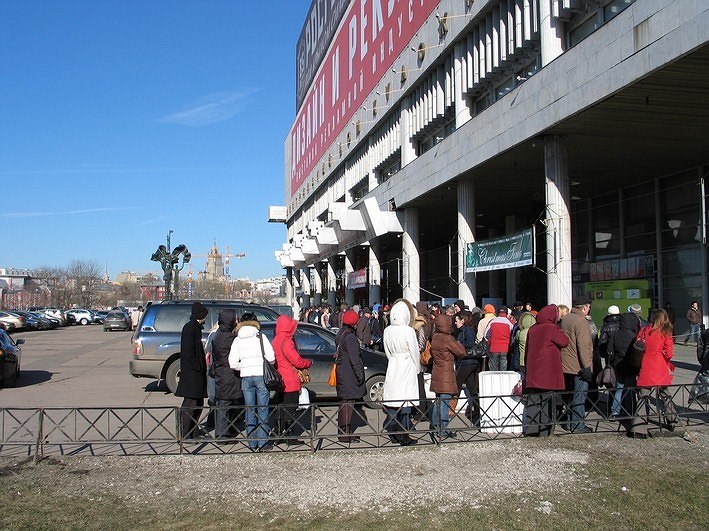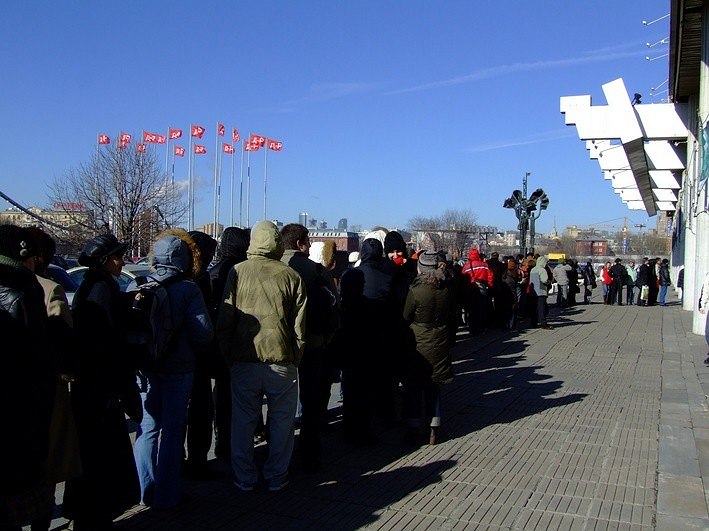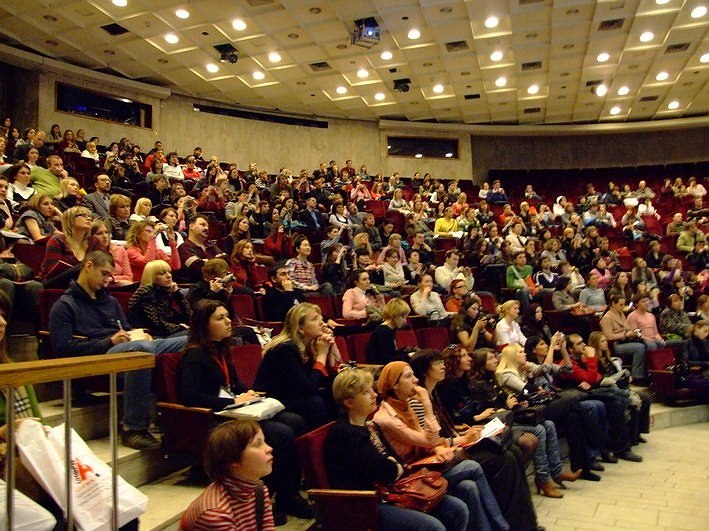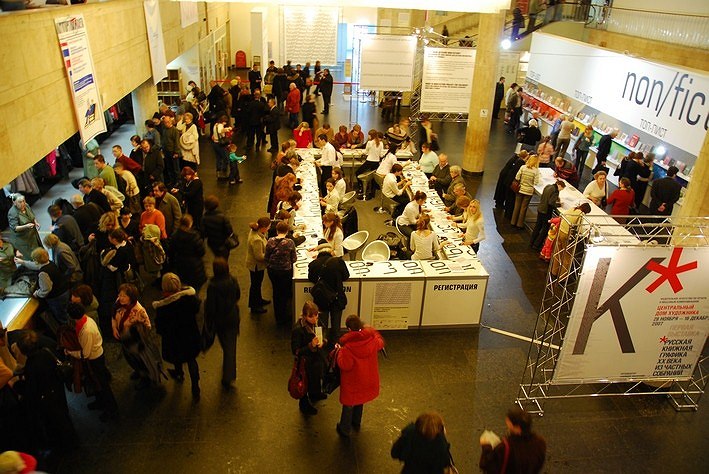At MIPIM-2008, held in Cannes, Elena Baturina presented the concept-project of mixed-use complex “Apelsin” [Orange], approved by Norman Foster. It has also been announced that the project will take part in tender for reconstruction of the existing Central House of Artists and State Tretyakov Gallery, it haven not been stated publicly yet and it is not known if it will ever be held. But the project is being grandly promoted, and discussions in media more often end with the conclusion that the old building is, well, of Brezhnev period and it is time to replace it with a nice one, designed by a world-known architect. They have torn down “Rossia” and “Inturist” hotels, and even “Moscow”, why not change something else to a brand-new international piece of work? Well, especially since not only Lord Foster has taken part in the project but also the developer Elena Baturina.
There are many questions concerning “Apelsin”. It combines the Tretyakov Gallery with elite residential accommodation and is a typical model of an “investment construction” when a developer builds something for a city adding more constructions to profit from. Do we have to give away the Central House of Artists and the State Tretyakov Gallery that have become popular centers of culture in Moscow, for investment construction? Does “Apelsin” look fine at that place? Is this the work of the world-famous “star” or more of the developer?
There is an important issue that is not to be left behind. Is it really necessary to pull the building down just because it is of Brezhnev period? Massimiliano Fuksas, the Italian architect and curator of Venice Biennale, speaking in Moscow, asked, “When will you start to value your 70’s”? Really – when? Very soon there will be nothing left. And that was an epoch. Indeed, it is full of panel stuff, but there were great works and the key constructions of the time – without them it will be hard to have a right image of it. It is well known that in those times the building by Nikolay Sukoyan and Yuri Sheverdyaev was a kind of manifest of modernist architecture. For USSR it was “our answer to Pompidou”, a high-technology development – after the project was done they gave about 100 applications for invention patents. Now, the building needs only a high-quality reconstruction and servicing.
Well, the project is already being widely discussed in media. And we think they lack professional opinions. Editorial stuff of archi.ru asked the architects and those who are interested in saving of the monuments, the two questions: Do they like Foster’s project? Is it better to save the present building of the Central House of Artists and the State Tretyakov Gallery?
We find the answers very interesting and comprehensive. These are the opinions of the professionals who know well and love Moscow.
Yuri Avvakumov:
First, Moscow had the Las-Vegas look with pseudo-towers, illumination and casinos, then resembled a central European office with checked glass, and now there is a new trend – Dubai with buildings-paintings. Moscow has been accurately destroying its uniqueness, its modernism of 1920’s and 1960’s, historical development of 19th century. Remarkably, architecture of Stalin epoch remains untouched. Might be due to fear for the Leader.
Evgeny Ass, the architect:
I would not like to discuss the architecture of “Apelsin”, though I do not like it. It is less important in this case. What is significant is cynicism of the developer and the architect, who do not really care what and where to build. The possible reason that he might be has not had the full information is groundless. If they asked him to design a project in the place of the Kremlin, he would pull it down and construct there because he would be paid for that. We have a precedent that makes worry for the professional ethics of “stars” and the ethics of developers who are ready for anything to gain money. They are ready to give away a national treasure, in particularly the collection of the Tretyakov Gallery. As to the Central House of Artists and the State Tretyakov Gallery – I liked to work with it, particularly, to take part in the contest for its reconstruction. And it seems to me the building really is much better than those that are being constructed nowadays. And I totally disagree this is a concrete monster as some people think, it just needs to be worked with, serviced and cared. I believe the building is absolutely adequate to the time and its position in the city does not bother me at all.
Yuri Grigoryan, the architect:
In my opinion, “Apelsin” is an unsuccessful project, even a bold one. I would not like it to be constructed. If they decide to destroy the present building – and I realize it will be hard for it to survive on the background of costly ground and ill taste that surrounds us – well, if they will destroy it, then it must be an open contest with a few rounds with open public discussions of the projects, with selection according to special criteria.
The “invasion” of the place has been offensive for Moscow citizens. I do not feel like talking about that, but the recent events rather point out the fact that the worse is likely to happen. But let hope for the better.
Bart Goldhoorn, the president of the holding company “Project Media”:
I do not understand why they need to tear down the Central House of Artists if there is a grand vacant territory around it. The land of the so-called park of art costs a lot but is used very ineffectively. Sadly the provocation is aimed at this building, whereas the problem is that the Moscow authorities has no urban management will, and for this reason now there is a dull empty space around the Central House of Artists. Why don’t they build museums, residential accommodation, shops, offices there.
Nikolay Lyzlov, the architect:
It seems to me this project (“Apelsin”) repeats mistakes of the previous one. The change is not at all smart, a box is replaced with a ball. All the bad qualities of the box remain in the ball. I guess the more rational solution is that the whole territory of the present Central House of Artists and the State Tretyakov Gallery is potential territory for development. There is no need at all in the existing park of sculptures. It is necessary to compact the area. I think they could get even more meters saving the building. All it needs is to be modernized and reconstructed, and the cemetery of sculptures could be turned into a fine residential accommodation. It requires work, the embankment should be maintained, the entrance to the museum must be placed from the embankment side – now the entrance to the Tretyakovka is not visible. This all could be turned into the Uffizi. But the ball is the same that there has been before. It is not really important whether I like it or not – but in a few years we will get what we have got today – reasonless spending.
Certainly I’m sorry for the building of the Central House of Artists and the State Tretyakov Gallery. I like this architecture and I think soon it will become a monument. And I’m awfully sad for the buildings of 1970’s that are being demolished today in Moscow. This layer is vanishing and I guess soon they will be very sorry for the lost. The reconstruction contest of the Central House of Artists and the State Tretyakov Gallery held a few years ago shocked me with the familiarity of approach to the development. As if there is a portrait of a person and everybody comes up and draws there something like moustache or horns or anything. No better than vandalism. There is nothing so bad in the contest itself, but it could be not that barbarian.
David Sarkisyan, the director of Museum of Architecture:
Many negative opinions of the present building are such because people are not wise enough to appreciate the epoch. Many people of fine taste told me, “what a superior building, are you really going to tear it down!” It has grand foyer, it is a grand building itself. The statements that it is in bad condition appear because we service it badly. Let’s repair it!
The Central House of Artists and the State Tretyakov Gallery complements Moscow, it is a part of history and is a monument of a particular time. Will repeat myself – no doubt the building must be saved.
The project of “Zolotoi Apelsin” [Golden Orange] is a co-creation of the developer and the Lord Foster – such things happen. The project itself is fine, I like Foster’s work and what he has already done for Moscow. But it is a too edgy urban planning solution to place “Apelsin” there. It is too large – the wish to make more money “blown” it to incredible size. Even if there have never been the building of the Central House of Artists and the State Tretyakov Gallery, they should have think whether it was right to place such a big orange there. It is wrong. There could be another place for “Aplesin” in Moscow. If someone is eager about that, there is municipal territory within “muzeuma”, houses can be built there. Price of land is high there, a wish to build and gain money is quite understandable. But let’s leave alone the architectural monuments! I think the building of the Central House of Artists and the State Tretyakov Gallery must become a monument.
Besides, there is another lapse – a gallery of such level cannot be built together with residential accommodation. A most valuable collection of Russian avant-garde is kept in Tretyakovskaya Gallery. A person cannot live in an apartment and know that there are avant-garde masterpieces under it. This is a wrong treatment of our collection.
Mikhail Khazanov, the architect:
I have always treated Sir Norman Foster with respect for his contribution in profession, for innovations in architecture, for honored regalia.
Actually it is fine that the best architects come to Moscow, there is a hope that there will appear outstanding, super-technological, super-modern objects.
The history of the Central House of Artist and the Tretyakov Gallery might be lacked the full information, and so maestro and his partners-architects did not completely realized the particular historical, cultural and law contexts.
Most likely they all got in wrongly with the object, they did not have the detailed information about all those many years of its hard history.
The Central House of Artists is the theme so familiar to all Moscow architects, artists, sculptors, art historians.
Not so long ago there was a contest on reconstruction of the building and development of the adjacent territories, and there were the winners. By all the open and silent rules of international architectural society they did not have to cross out the contest project at once, chosen by the reputable professional jury, even if it was not relevant anymore, not rational and not profitable.
I’m not sure about the procedure in such situation – it is an issue for a professional discussion, but if results of the architectural contest, held according to all the established rules, are suddenly canceled without any explanations, it will be understood as a challenge not only to architectural corporate ethics but also to urban cultural life.
Seemingly this is an odd story, it has some hastiness, emotionality, some impulsiveness. Well, they did not have to “demonize” the situation at all, because hardly such an active object of aggressive-nonlinear architecture will soon be really constructed by the Kremlin.
Though, the story with the Gazprom’s skyscraper in St. Petersburg also was firstly considered as something not that serious…
And in our environment there is a risk to discredit, by a single and quite occasional urban planning replica of the whole “new wave”, the entire architectural mainstream, particularly in sovereign and conservative Moscow, where all got tired from everlasting historical reminiscences, but at the same time they can hardly think of anything greater than decorative boxes and chests.
I believe Moscow is worth to have new grand and challenging architectural events of international scale, everything depends on how precise, intelligent and correct new urban sights will be, but not destructive for history of the formed urban environment.
Definitely, the situation is not ordinary. Well, in architecture not so often radical avant-garde and radical derriere-garde change places.
And I am still sure there must be professional architectural contests for significant urban objects of the capital, they must be open, and juries must have the best of world-known architects, architects-theorists, and architectural critics.

